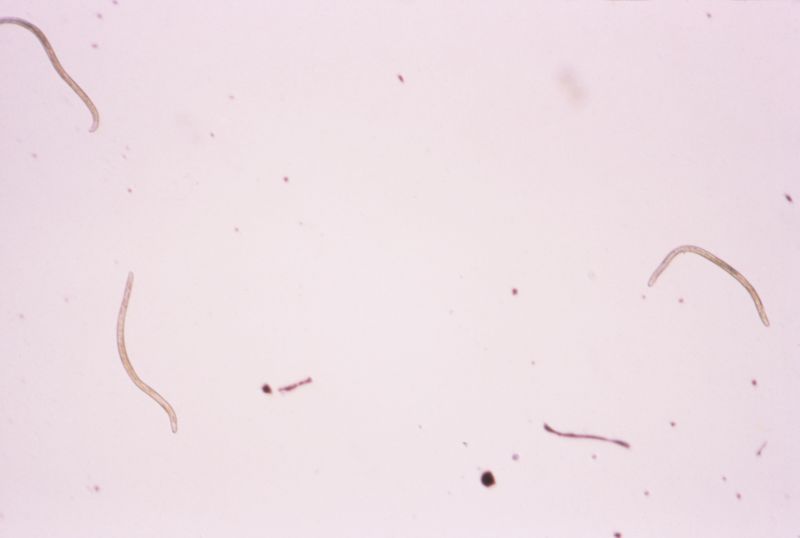Onchocerciasis
| Onchocerca volvulus | ||||||||||||||
|---|---|---|---|---|---|---|---|---|---|---|---|---|---|---|
 O. volvulus, the causative agent of river blindness.
| ||||||||||||||
| Scientific classification | ||||||||||||||
| ||||||||||||||
| Binomial name | ||||||||||||||
| Onchocerca volvulus Bickel 1982 |
|
Onchocerciasis Microchapters |
|
Diagnosis |
|---|
|
Treatment |
|
Case Studies |
|
Onchocerciasis On the Web |
|
American Roentgen Ray Society Images of Onchocerciasis |
Editor-In-Chief: C. Michael Gibson, M.S., M.D. [1]
Overview
Onchocerciasis (pronounced Template:IPA) or river blindness is the world's second leading infectious cause of blindness. It is caused by Onchocerca volvulus, a Parasitic worm that can live for up to fourteen years in the human body.
Life cycle

The life cycle of O. volvulus begins when a parasitised female Black fly of the genus Simulium takes a blood meal. Saliva containing stage three O. volvulus larvae passes into the blood of the host. From here the larvae migrate to the subcutaneous tissue where they form nodules and then mature into adult worms over a period of six to twelve months.
After maturation, the smaller adult males migrate from nodules to subcutaneous tissue where they mate with the larger adult females, producing between 1000 and 3000 eggs per day.
The normal adult worm lifespan is up to 15 years. The eggs mature internally to form stage one microfilariae, which are released from the female's body one at a time and remain in the subcutaneous tissue.
These stage one microfilariae are taken up by black flies upon a blood meal, in which they mature over the course of one to three weeks to stage three larvae, thereby completing the life cycle. Humans are the only definitive host for O. Volvulus. The normal microfilariae lifespan is 1-2 years.
Causes of morbidity
Adult worms remain in subcutaneous nodules, limiting access to the host's immune system. Microfilariae, in contrast, are able to induce intense inflammatory responses, especially upon their death. Dying microfilariae have been recently discovered to release Wolbachia-derived antigens, triggering innate immune responses and producing the inflammation and its associated morbidity. Wolbachia species have been found to be endosymbionts of O. Volvulus adults and microfilariae and are thought to be the driving force behind most of O. Volvulus morbidity. Severity of illness is directly proportional to the number of microfilariae and the power of the resultant inflammatory response.
Skin involvement typically consists of intense itching, swelling, and inflammation. A grading system has developed to categorize the degree of skin involvement:
- Acute papular dermatitis - scattered pruritic papules;
- Chronic papular dermatitis - larger papules, resulting in hyperpigmentation;
- Lichenified dermatitis - hyperpigmented papules and plaques, with edema, lymphadenopathy, pruritus and common secondary bacterial infections;
- Skin atrophy - loss of elasticity, skin resembles tissue paper, 'lizard skin' appearance;
- Depigmentation - 'leopard skin' appearance, usually on anterior lower leg.
Ocular involvement provides the common name associated with onchocerciasis, river blindness. The surface of the cornea is another area to which the microfilariae migrate, where they are also attacked by the immune system. In the area that is damaged, punctate keratitis occurs, which clears up as the inflammation subsides. However, if the infection is chronic, sclerosing keratitis can occur, making the affected area become opaque. Over time the entire cornea may become opaque, thus leading to blindness.
Treatment and control
The treatment for onchocerciasis is ivermectin (Mectizan); infected people can be treated once every twelve months. The drug paralyses the microfilariae and prevents them from causing itching. In addition, while the drug does not kill the adult worm, it does prevent them from producing additional offspring. The drug therefore prevents both morbidity and transmission.
Since 1988, ivermectin has been provided free of charge by Merck & Co. through the Mectizan Donation Program (MDP). The MDP works together with ministries of health and non-governmental development organisations such as the World Health Organization to provide free Mectizan to those who need it in endemic areas.
There are various control programs that aim to stop onchocerciasis from being a public health problem. The first was the Onchocerciasis Control Programme (OCP), which was launched in 1974 and at its peak covered 30 million people in eleven countries. Through the use of larvicide spraying of fast flowing rivers to control black fly populations and, from 1988 onwards, the use of ivermectin to treat infected people, the OCP eliminated onchocerciasis as a public health problem. The OCP, a joint effort of the World Health Organisation, the World Bank, the United Nations Development Programme and the UN Food and Agriculture Organization, was considered to be a success and came to an end in 2002. Continued monitoring ensures that onchocerciasis cannot reinvade the area of the OCP.
In 1992 the Onchocerciasis Elimination Programme for the Americas (OEPA) was launched. The OEPA also relies on ivermectin.
In 1995 the African Programme for Onchocerciasis Control (APOC) began covering another nineteen countries and mainly relying upon the use of ivermectin. Its goal is to set up a community-directed supply of ivermectin for those who are infected. In these ways, transmission has declined.
According to a study in the British medical journal The Lancet, the worm may be developing resistance to ivermectin. [1]
See also
- Carter Center River Blindness Program
CDC Parasites of Public Health Concern [2]
References
- ↑ http://news.bbc.co.uk/2/hi/health/6753003.stm BBC News | Health: River blindness resistance fears. Accessed 15 Jun 2007.
External links
- Mectizan Donation Program
- Merck & Co., Inc
- River Blindness Documentary "37 Million and Counting" by Aaron Edell
- http://www.sightsavers.org/Who%20We%20Are/Interactive/Videos/World4572.html
- http://www.cbm.org/en/general/CBM_EV_EN_general_article_17601.html